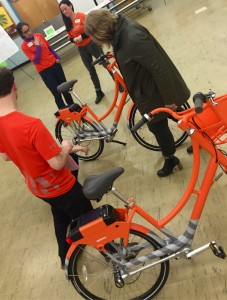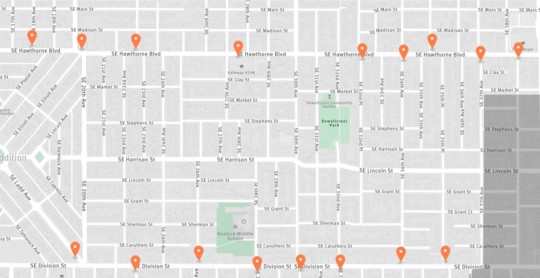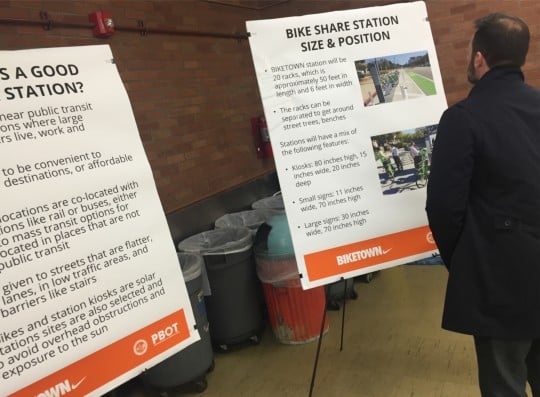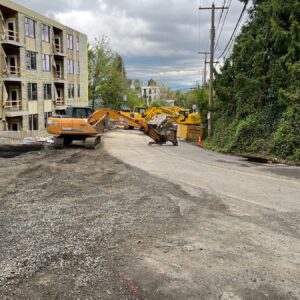The biggest thing to keep an eye one when it comes to Portland’s bike share system isn’t where the stations might go, it’s where they might not go. That’s one of the things I learned at the first open house for Biketown, the Nike-sponsored bike share system the Portland Bureau of Transportation is set to roll out about four months from now.
Last night’s event was one of five open houses that will take place between now and April 7th. PBOT will use them to solicit feedback for where to locate the system’s docking stations. As we reported earlier this month, the city has come up with 300 candidate station locations and they need to whittle that number down to 100.
The 300 proposed sites were chosen by a planning consultant hired by PBOT who worked with a technical advisory committee. They used a combination of factors to make their decisions including things like: access to transit, bike traffic demand, proximity to affordable housing and major destinations, and so on. The stations themselves will have 20 racks, be about 50 feet long and six feet wide.
With that as a backdrop, here’s what I took away from the open house last night…
People are chomping at the bit for bike share
Since PBOT launched their interactive map and asked people to suggest station locations seven days ago, there have been over 3,655 suggestions. That’s a lot of feedback. This demonstrates pent-up demand and interest in bike share — which isn’t surprising given that we’ve been waiting nearly a decade for a system to launch. And last night, even though there weren’t a lot of people at the event (unfortunate conflict with big meetings on air quality and school boundaries), everyone was engaged and filling out comment cards.
Where stations are proposed
The maps shown at the open house were much easier to read than the online one. After staring at each of them (there was a separate map for northwest, southwest, north/northeast, northwest and southeast quadrants), I started to see some interesting trends.
PBOT has proposed multiple stations on many streets where people don’t ride. Streets like NW Lovejoy, SE Division, N Mississippi, SE Hawthorne, SE/NE Grand, NW Lovejoy and NW 23rd are filled with destinations but people tend to avoid riding on because they don’t feel safe or welcoming. What will happen when someone grabs a bike from one of the stations on Hawthorne and then rolls into the street where they have to squeeze between parked cars and a lane shared with people driving cars? Or on Lovejoy which is filled with tire-eating streetcar tracks? Will this result in lots of conflicts or a backlash and/or will it be the big push PBOT is waiting for to gain the political and public will to improve bike access on these streets? When I brought up these questions for PBOT staff at the open house, they didn’t have answers, but they appreciated my feedback.
On the flip side, I was pleased to see so many stations proposed in places that really stand to benefit from bike share: NE Multnomah, especially near Lloyd Center Mall; the Rose Quarter and Moda Center; Portland Community College’s Cascade campus along N Killingsworth; N Williams; the South Park Blocks, and so on.
Another pattern that emerges from PBOT’s candidate locations is where we might end up seeing the new protected bikeways coming as part of the planned Central City Multimodal Safety Project. They’ve proposed multiple stations on SW Stark and Oak, NW Everett, SW Jefferson, and SW 3rd and 4th. Those streets could form part of a future protected bikeway network. No one knows where those bikeways will go, but it’s reasonable to think PBOT might use a similar criteria for them as they’ve used for bike share stations.
Advertisement
Where stations aren’t proposed
And then there are the places conspicuously absent from PBOT’s initial list of station locations. For example, the Central Eastside Industrial District is devoid of stations despite it being a growing center of commerce and a place many people think might be “the next Pearl District.” Turns out the model used to determine good station locations showed that there wouldn’t be a lot of demand in the CEID. It also falls victim to the same rationale PBOT used for not including NE Alberta Street in the service area: a lack of “contiguous density.”
It was also surprising that the downtown transit mall (SW 5th and 6th) and Waterfront Park do not have any proposed stations. Both of these locations would seem to have tons of demand. According to PBOT, they are currently meeting with the Parks Bureau to hammer out right-of-way issues. Same goes for the transit mall. PBOT says any stations on 5th or 6th have to get special approval from TriMet due to design standards on the mall (recall that TriMet doesn’t even allow PBOT put their blue staple racks on the mall).
What’s next
Once PBOT has collected all the public input, they’ll feed it through their station location planning rubric and scorecard. Then the final 100 locations will ultimately be determined by PBOT Director Leah Treat.
Keep in mind that unlike most PBOT bike projects, the public process for bike share will be very quick. They’ll wrap up these open houses in just a few weeks and then they’ll have to start prepping for the July launch. Stay tuned.
— Jonathan Maus, (503) 706-8804 – jonathan@bikeportland.org
BikePortland can’t survive without subscribers. It’s just $10 per month and you can sign up in a few minutes.












Thanks for reading.
BikePortland has served this community with independent community journalism since 2005. We rely on subscriptions from readers like you to survive. Your financial support is vital in keeping this valuable resource alive and well.
Please subscribe today to strengthen and expand our work.
Very disappointing to hear about the lack of service in the CEID. This shows a failure of the way PBOT uses models: the past truly is not a good indicator of the future because of the scale and nature of change happening here.
Also, I spoke with someone at tat the OATS conference who claimed to know that is the Portland Business association lobbying against placing these stations on the street where they belong! Our pedestrian space is far too valuable to be wasted on storing bikes! I was pretty excited about bike share until I learned about the sidewalk compromise and the fact that people under the age will be forbidden! Its a damn shame
Don’t worry, I’m sure quite a few of the bikes will end up under bridges in the CEID.
Edit: the phrase is “champing at the bit” not “chomping.” The phrase refers to a horse with a bit in its mouth.
Yes, but how often do you hear someone use the word “Champ”?
http://grammarist.com/usage/champing-chomping-at-the-bit/
It sounds like either way is acceptable.
See? Do it wrong long enough, and it becomes correct!
Just like using cars for everything!
If the writer is going to use the phrase to headline a certain mood (eagerness, pent-up demand) than the writer needs to use the phrase correctly as it was intended. Otherwise, he shouldn’t make the effort to use the phrase. It doesn’t matter how often ” you hear someone using the word champ” — the word exists, the word is used and in this case using “chomping” was incorrect.
According to Merriam Webster:
Full Definition of champ
transitive verb
1: chomp
2: mash, trample
intransitive verb
1: to make biting or gnashing movements
Full Definition of chomp
intransitive verb
1: to chew or bite on something
2: champ 2 —usually used in the phrase chomping at the bit
transitive verb
1: to chew or bite on
So, sounds like the two words are synonyms.
The dead horse has been thoroughly beaten. Let’s get back to riding bikes, shall we? 😉
Okay by me.
You’re my “champion”
Based on my experience with bike share, visibility and proximity to the start/end destination are crucial. So even if there aren’t good bike facilities on Hawthorne/Division themselves, that’s where a good chunk of trips in the area are going to start and end, and the closer a station is to your destination, the more convenient it is. As an example, let’s say I live in an apartment at 20th and Hawthorne and want to cycle to Sen Yai on 34th and Division (either to eat there or because I work there). I want a station as close to my starting point and ending point as possible, which means putting them on streets with high residential and commercial/business density rather than on popular bike routes, as long as there is a safe way to get to/from the bike station from either N/S or E/W (doesn’t have to be both), and our street grid helps this enormously. Plus, due to high traffic volumes of peds/transit riders/drivers on Hawthorne and Division, those stations are going to be well-known, and maybe prompt a few non-cyclists to think “gee, I’m seeing these everywhere! Maybe I should take it for a spin too.” So while I agree that having bike share on for instance Hawthorne may help push the issue of bike lanes on Hawthorne, there are reasons beyond that to support bike share on arterials.
One thing that’s absolutely crucial, however, is remembering to put stations where people live, not just “destination” spots! Our low-density R2.5-5 housing makes this really difficult to do efficiently, but there are a few spots that I’d recommend (such as Ladd’s Circle or places >3 blocks where that two well-utilized greenways meet). Having a bike share station two blocks from my apartment was about 50% of what prompted me to sign up for bike share when I lived in Chicago, and low-and-behold most of my trips either started or ended at that station.
It’s hard for me to get very excited about where the stations go. I don’t expect that I’ll use one; I have a appropriate bike for whatever use I make of it.
I think the bikes are most likely tourist attraction transport and sightseeing devices. I can see someone wanting to ride to OMSI, but I’m not aware of too many other attractions in the Central Eastside.
Are those of you providing suggestions basing those recommendations on whether you would actually use one or are you basing it on where you think other people should ride?
I hope the system does great, but I’m not terribly optimistic.
As someone who uses transit more often than my bike, I expect I will use bike share a lot for one-way trips.
The big difference between bike share bikes and privately-owned bikes is that only a bike share trip can be one-way. If you want to ride the bus to a destination and then ride a bike back (because the weather got really nice, because the buses stopped running, because you need to make a detour to the grocery store which is not along the bus route, because you want to join your friend/partner who did cycle there on their trip home, etc.), unless you had the foresight of bringing your bike with you on your trip out, you’re out of luck without bike share. Plus bike share helps with the last-mile problem, and is a great backup if your bike conks out on you (or gets stolen).
I got tired of maintaining my car, so I sold it and use Car2go and Zipcar. I’m getting tired of maintaining my bike (10 flats a year, oiling the chain, adjusting brakes, etc…), so I’ll sell it and use bikeshare. I am a pretty lazy person though in my old age.
Yeah nothing ever happens at the Memorial Coliseum, Moda Center, Convention Center, countless bars and clubs, Emmanuel Hospital, Lloyd Center (ok you might have a point with Lloyd).
And how many those destinations are in the Central Eastside Industrial District?
The examples you cite are those which could be tourist destinations which is where I think it makes sense to locate stations.
I got tired of maintaining my car, so I sold it and use Car2go and Zipcar. I’m getting tired of maintaining my bike (10 flats a year, oiling the chain, adjusting brakes, etc…), so I’ll sell it and use bikeshare. I am a pretty lazy person though in my old age.
Have you looked into Schwalbe Marathon Plus tires? I get maybe one flat a year on them. Conti makes some good flat-resistent touring tires too.
Panaracer Ruffy Tuffy is another good option.
Really people don’t ride Division, Hawthorne, Lovejoy, Missississippi…etc????.
Many of us do, and do so often. And I suspect they’d be rented more stationed on the commercial districts than if they were stationed on the Greenways.
You want lanes on those streets commercial corridors? – bike share will be the egg.
Correct me if I am wrong, but I believe a “station” is basically some bike racks and an entry in a database? And I believe the system will allow you, for an additional fee, to leave a bike locked to any public bike rack and to take a bike from such a rack, even if it is not a designated station?
So, minimal capital investment or time required to add a station or remove a station. If bikes are regularly being left in an area without a station, that will tell Biketown that a station should be added there. If bikes are seldom left at a station, that will tell Biketown that the station should be moved elsewhere.
My feeling is, the decision of where to initially place stations is somewhat important but hardly critical. What will be more important is a responsive, accurate, and continual process to analyse location data for the bikes and figure out where stations should be added and deleted in future weeks, months, and years. Dynamically.
For example, maybe in five years the CEID will eventually become an area popular with people who use bikeshare – who are, as many have noted, not necessarily going to be the same people who bike regularly in the city today. Probably more visitors and casual or occasional cyclists, fewer committed daily bike commuters riding every day to jobs in the CEID. When that happens, Biketown will see it because bikes will be left on public racks in the CEID, and then stations can be placed there. There is no need to put stations in the CEID today in hopes that they will be needed five years from today.
I do think the stations should be on the street, as bike corrals. They will only take up one parking space, and all those people arriving by bike rather than car will actually free up parking elsewhere on the block. The city should commit to removing or shrinking stations that are not much used.
I am curious how much of a problem theft is expected to be. How robust are the bikes’ built-in locks, how easy will they be to steal, how valuable will a stolen bikeshare bike be? Are the components compatible with standard bikes?
Yes John. You make some good points. It’s important to remember that the stations for this system are easy to move and you are not required to park in them. PBOT will strongly encourage users to park in the stations both through educational/outreach and via financial incentive. The importance of station siting as it relates to the success of this system remains to be seen. Portland will be the largest and most populous city to use this “smart bike” system.
Given Commissioner Fritz’ very vocal opposition to bike share, I am not even the least bit surprised at the lack of bike share stations in Waterfront Park.
Speaking of Ms. Fritz, has everyone seen that she has a challenger? I would love to hear about some of her views on cycling. http://www.wweek.com/2016/03/07/ann-sanderson-street-fee-foe-also-files-to-run-against-amanda-fritz/
Unfortunately, Fritz at least talks a much better pro-active transportation game than Ann, who doesn’t even seem to have it on her radar.
*Berated people for cycling on sidewalks despite the lack of infrastructure.
*Equated all cyclists with stop-sign running scofflaws.
*Categorically opposed mountain biking and helped sabotage the public process.
*Suggested bicycle license fees as a funding source for the bike plan.
*Sought to remove cycling from it’s #2 current position in the green transportation hierarchy.
Most days after work, I’m heading somewhere other than home first. I usually take TriMet or walk, both of which are much slower than riding my bike, because I am always concerned my bike will get stolen while I’m in a grocery store or wherever else I’m going. So my bike sits in my apartment waiting for weekend rides where I don’t have to lock up and worry.
I’ll be using bikeshare pretty much every day once it comes here, since it will be significantly faster than TriMet/walking (not even accounting for the all-too-common MAX delays or buses stuck in traffic). So when I’ve recommended stations on the online map, it’s been places where I would use it all the time, as well as places where I would use it occasionally, or where I don’t use it right now but I might in the future.
My hope, of course, is that it will prove so successful in the launch area that it moves outward a little every year, and that people see how useful it is and start clamoring for it in their neighborhoods too (I feel like this is already happening with those who were left out of the initial service area). While it sucks that the service area is so small, I do really think it will allow for immediate success and a good opportunity to steadily expand (and fill in the gaps) in the coming year.
While the staff weren’t really able to answer my questions, it was nice to finally see the bike in-person! They seem a lot less clunky than the bike share bikes in Chicago/DC/NYC. Also, I like that they have a real basket instead of those odd L-shaped racks that don’t hold much other than a small purse or bag.
My questions were:
* What happens if you try to end a trip outside the service area? Does the bike not let you or does it just charge you a penalty later?
* The lock-yourself bikes have a bit higher of a learning curve for new riders than docking systems. What happens is someone locks up the bike poorly (say to a short post) and the bike gets stolen? Is the person who locked it last liable for the theft? Does BIKETOWN have an insurance policy that covers this situation?
400-500 Citibikes bikes are stolen each year. At $500/bike cost (guess), that is a lot of cost ($200K-$250K). They aren’t stolen from the docks, usually, because those are extremely secure. Instead, they are stolen when the user leaves them unattended while going into a shop or something. I believe in that case, the user is financially responsible. So maybe Citibikes recoups some of the loss from the users’ credit cards.
http://nypost.com/2015/08/25/people-have-stolen-more-citi-bikes-this-year-than-ever-before/
In Portland’s system, if the bike is stolen when locked to a station or a public rack, or parts are stolen off a bike, who is responsible? I imagine Bikeshare will bear that cost. I imagine the Biketown bike’s integrated U lock + a standard rack will be a less secure combination than the Citibikes bike’s locking shackle + the shielded docking station.
I hope that Biketown has budgeted for hundreds of stolen bikes each year, and that PPD gets a lot more serious about bike theft now that it will start hitting the city’s own coffers.
“At $500/bike cost (guess)”
$1200, actually.
“Immediately notify us by calling 1-855-BIKE-311(245-3311). You must do this within 24 hours. The customer service representative you speak with will ask you to fill out a Citi Bike Theft Report form. In addition, we request that you call or visit the police precinct in which the theft occurred within 24 hours to file a theft report. Your credit card may be charged for the cost of recovery or replacement of the bike up to $1200.”
476 Citi Bikes were stolen in 2015, as of December 21st.
So New York is losing about more than a half a million worth of bikes a year through theft (not sure how many are recovered), when Portland’s entire O&M budget for bike share is $1.5 – $2 million a year.
Given the ingenuity of Portland bike thieves, one wonders how popular the system will be when people start getting hit with a $1200 bill for having a rented bike stolen (assuming the bikes costs as much as in New York).
Or is Portland planning on eating the costs of theft of the bikes, rather than passing the cost on to users?
That’s what I’m wondering.
I don’t see how Biketown can charge a user for the subsequent theft of a bike that he left properly locked to a rack.
The bikes are distinctive and presumably many of the components aren’t compatible with standard bikes. So I’m not sure what value they’ll have to a thief. But the same is true for Citibikes bikes, and they get stolen. I guess if you are riding one if these bikes, no one can tell if you rented it or stole it.
The SiBi bikes look more like “normal” bikes than Citi bikes, so a good paint job can cover up the branding. However, the shaft drive is a dead giveaway.
I am hopeful that bike share in Portland will have the effect that I saw in DC last week. When I lived in DC 20 years ago I would have never ridden a bike in the City, on the street. 5 years ago there were great MUPS, but still very few bikes on the street. Now, with bike share, there are bike lanes all over, sharrows on the roads that don’t have bike lanes, and more bike commuters than I had ever seen. And from talking to locals, it was bike share and their locations in prominent areas on main roads that led to the bike infrastructure appearing on those roads (or simply critical mass of cyclists on the roads). Riding in DC was pleasant and fun, even in the midst of significant city traffic. It could be that is what PBOT is hoping for with the placement of the bike share stations on Division and Hawthorne.
Why are there so many along Hawthorne when it is such a nightmare to bike on?
Odd that you would call out Hawthorne, which is better to ride on than either Division or Belmont.
Personally, I have no problem with Hawthorne. East of 39th, the lanes are wide and cars can use the turn lane to pass. West of 39th, the lane isn’t wide enough to share, but good news… there are four lanes. Force motorists to use the other lane to get past you and you’re golden.
These streets are all okay to ride on.
Division traffic is really slow and congested, so a cyclist can keep up.
Belmont lanes are wide enough for co-existence.
Hawthorne works for the reasons you said.
Anyway, people can take side streets to get to the area they want to, then cut over to the major street.
Jonathon, I don’t get your criticism of stations on Hawthorne, Division, etc. They don’t mean your supposed to bike on those streets. If you’re riding far, you would take a side street from/to the station over to one of the better biking streets like Clinton, Lincoln, Salmon, or 34th. That’s what most people do now on their own bikes and then lock them up at a rack near their destination on the commercial, not very bike friendly, street.
I have another question about “how will this work”.
How are the bike’s electronics powered – in other words, how is the battery recharged?
The reason I ask is, this appears to be the first use of the Social Bicycles system in a climate as gray and generally non-sunny as ours. I wonder if the solar panel will keep the bike’s electronics charged.
Tourists don’t have your local bike route knowledge, and neither do new-to-biking locals. When I rent bikes in other cities, I typically ride away from the station on the street it was on, assuming they put it there for a reason. If it sucks, I get off of it, but it might be too late in some cases